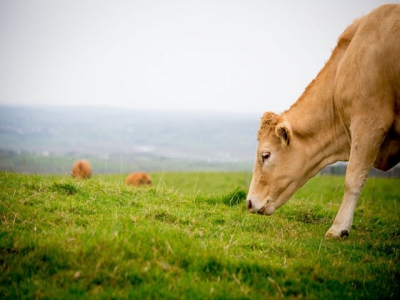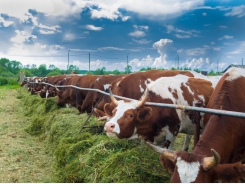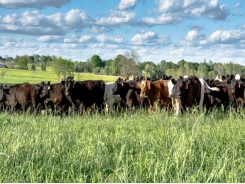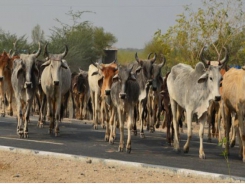Swapping high dietary protein levels for fermentable carbs may limit N emission in dairy co

Lowering protein levels and increasing fermentable carbohydrates in concentrates fed to dairy cows on pasture may boost nitrogen use efficiency and reduce emissions into the environment, say researchers.
Photo © GettyImages/Albina Kosenko
An international team of researchers from the National Agrarian University La Molina in Peru and the University of Hohenheim in Germany explored the use of differing levels of protein and starch in feed concentrate mixtures (CM) for dairy cows also on a mixed grass and legume pasture.
The group published its work in the journal Livestock Science.
“The overall aim of the present study was to analyze the effects of a supplementation of lactating dairy cows grazing a mixed grass-legume sward with CM differing in their concentrations of rumen-degradable CP and readily fermentable carbohydrates,” the researchers said.
“It was expected that reducing CP concentrations while increasing starch contents in CM would not reduce feed intake and diet digestibility and therefore enhance energy supply to both, rumen microbes and the cow; would consequently increase milk yield, milk protein content and yield, and feed conversion efficiency; and would not, or only minorly, affect fecal N excretion, but would reduce urinary N losses and improve overall N use efficiency.”
The researchers found that total intake of organic matter (OM) was not altered by the concentrate fed, however, the added concentrates did alter the digestibility of OM, daily milk yield and nitrogen (N) use efficiency.
Yield was lowest when cows received a diet with a low protein and high starch concentrate, but N efficiency was higher for cows on that diet than on the others tested.
“Supplementing dairy cows on mixed grass-legume swards with readily fermentable carbohydrates may slightly reduce diet digestibility and milk yield, if the CM is offered a considerable time before grazing,” they said.
“Reducing RNB [rumen nitrogen balance] in diets of dairy cows, for instance, by decreasing rumen-degradable CP and increasing non-structural carbohydrate supply, reduces urinary N excretion and greatly improves overall N use efficiency, both at animal and likely also at farm level.”
“The CP [crude protein] supply from protein-rich forage mixtures appears sufficient to cover the requirements of dairy cows with milk yields of about 13 kg/d,” they added.
Why change protein and starch levels?
The recommended amounts of crude protein for use in dairy cow diets include safety margins based on “uncertainties” in the estimates of the rumen degradability of feed crude protein and intestinal digestibility and the efficiency of rumen microbial protein synthesis, the researchers said. Concentrate mixtures (CM) used in dairy cow diets often include expensive, high-quality protein sources.
When crude protein amounts in feeds exceed the needs of rumen microbes and the cow, the amount of nitrogen (N) excreted, particularly in urine, increases and nitrogen efficiency or milk nitrogen per unit of nitrogen intake falls, they said. Urinary N can enter the environment and may pollute air and water.
There is an interest in reducing the intake of CP by dairy cows from both an environmental and economic perspective, they said. And there is interest in maximizing the use of local, protein-rich forage material.
Reducing the intake of CP, especially rumen-degradable CP, help reduce total N excretion, they said.
“Increasing dietary concentrations of readily fermentable carbohydrates increases the proportion of N from rumen-degradable CP that is incorporated into microbial protein, so that the ingested N is more efficiently used to produce milk,” they added.
Together, both processes limit dietary rumen N balance (RNB) or the total CP at the “duodenum minus endogenous protein,” the researchers said.
However, previous studies on negative RNB in dairy feeds have been contradictory regarding feed intake and cow performance, they added.
“Limited knowledge exists on reducing rumen-degradable CP intake, while increasing metabolizable energy (ME) concentrations (i.e., overall decreasing RNB) in diets based on forage legumes, which can greatly replace protein from concentrates in dairy cattle diets without negative effects on animal performance and milk protein contents,” they said.
“Under pasture conditions, when diet ingredients are offered separately, the type of supplement feed and its chemical composition, however, greatly determines substitution of forage by supplements and thus total feed intake of grazing ruminants, which may partly offset the efficacy of concentrate use in livestock feeding.”
Methods and materials
In the feeding trial, 20 cows were given one of three trial concentrate diets in addition to pasture for a 19-day period before rotating to another of the diets, the researchers said.
The feeding periods included 14 days of adaptation to the feed and 5 days for sampling.
The diets included maize silage, grazing on a mix of alfalfa-clover-rye grass and different CM, they said.
The concentrates tested were a control or high protein, low starch diet (HPLS) with 4kg/d of dried distillers grains with solubles and no maize kernel meal (MM); a diet with both 2.5kg/d DDGS and 1/5kg/d MM for a medium protein, medium starch (MPMS) diet; and a diet with 1kg/d DDGS and 3kg/d MM for a low protein, high starch (LPHS) concentrate.
“The three CM were designed with the intention of decreasing dietary rumen-degradable crude protein supply and promoting rumen microbial protein synthesis through increasing fermentable carbohydrate intakes,” they added.
Daily milk yield for each cow was recorded and CM and maize silage intake and refusal were calculated and noted, they said. Milk samples, along with the different ingredients and pasture fed, were collected and analyzed.
Urine samples and fecal also were collected daily and checked for N concentration, the researchers said.
The apparent total tract digestibility of organic matter (ivdOM) and metabolizable energy (ME) concentrations in the feed were determined, they said. The feed conversion efficiency also was calculated.
Daily organic matter intake was estimated and used to calculate the organic matter intake from CM, silage and pasture herbage, they said. The average nitrogen, crude protein and non-detergent fiber (NDF) concentrations in the diet also were determined and the RNB of individual feeds was estimated.
Results
The average intake of the CM provided ranged from 1.7 to 3.4kg OM/d or about 15 to 38% of the daily OM, said the researchers. Intake was slightly lower for the LPHS diet than the HPLS diet, however, OM intake from pasture did not change and total OM intake was similar across the diets.
“Feeding CM low in rumen-degradable crude protein and rich in readily fermentable carbohydrates may slightly reduce diet digestibility and milk yield in dairy cows grazing mixed grass-legume swards, but can greatly improve N use efficiency and lower the risk of N emissions into the environment,” they said.
Dietary concentrations of CP fell from 212g to 195g to 155g/kg dry matter for the HPLS, MPMS and LPHS diets, respectively, they said. Concentrations of NDF were highest for the HPLS diet and lowest for the LPHS diet.
“Estimated RNB of the diets ingested by cows were highest for HPLS and lowest for LPHS,” they added.
Daily milk yield and efficiency of feed use for milk production tended to drop for cows on the LPHS diet compared to the HPLS diet, but milk fat contents were similar for all feeds, the researchers said.
“Daily yield of fat tended to be lower for LPHS compared to HPLS and MPMS. Yields of milk protein and lactose did not differ between diets, as contents of protein and lactose in milk increased from HPLS to MPMS and LPHS,” they added.
Lowering the amount of DDGS in the concentrate also reduced the N intake of the cows, they said. Fecal dry matter concentrations were higher for the HPLS diet than the LPHS diet, but fecal N levels and fecal N excretion did not alter based on diet.
However, the concentration of urinary N was highest when the HPLS diet was fed and lowest for LPHS and estimated urinary N excretion also was reduced with the LPHS diet compared to the HPLS diet
“Milk N concentration increased from HPLS to LPHS with 5.49, 5.53, and 5.57 g/kg, respectively,” they said. “However, due to the tendency of a higher daily milk yields for LPHS, total excretion of N in milk was similar for all diets. Accordingly, N use efficiency (in g milk N per g of N intake) increased from 0.189 (HPLS) to 0.209 (MPMS) and 0.249 (LPHS).”
Source: Livestock Science
Authors: U. Dickhoefer, S. Glowacki, C. Gómez, J. Castro-Montoya
Có thể bạn quan tâm
Phần mềm

Phối trộn thức ăn chăn nuôi

Pha dung dịch thủy canh

Định mức cho tôm ăn

Phối trộn phân bón NPK

Xác định tỷ lệ tôm sống

Chuyển đổi đơn vị phân bón

Xác định công suất sục khí

Chuyển đổi đơn vị tôm

Tính diện tích nhà kính

Tính thể tích ao hồ




 Heat stress has lasting effects on dairy cows
Heat stress has lasting effects on dairy cows  Dwarf cattle breeds make cool cows
Dwarf cattle breeds make cool cows